5
Newcomen’s Seesaw Steam Engine
Miss Tumble told the children about one of
the first steam
engines, which was invented by a man called Thomas
Newcomen. In this engine the pressure of steam and the pressure
of the atmosphere were both used to cause a beam, which was
like a seesaw, to rock.
This engine would have been too
complicated for school kids to understand straight away, so
Miss Tumble drew diagrams on the blackboard to explain how it
worked. Also, Miss Tumble used a bicycle pump to explain the
idea of a piston
that moved up and down within a cylinder.
She held the bicycle pump upright and blew into the bottom end.
This caused the handle to move upwards. Then she took the
bicycle pump apart and showed the children the piston inside.
After that the children all knew what a piston was. Miss Tumble
was a very organized person. She had a box of baby wipes ready
to clean her hands after touching the inside of the pump. Many
of the kids had bicycles and they enjoyed seeing Miss Tumble
blowing into the bicycle pump.
Freddie asked whether Newcomen’s
engine had been used to operate bicycle pumps. Miss Tumble
didn’t think so, but said that many early steam engines
had been connected to water pumps, which were somewhat similar
in construction to a bicycle pump.
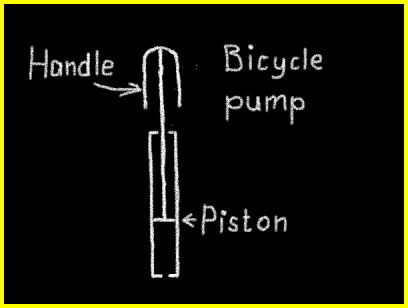
Bicycle pump
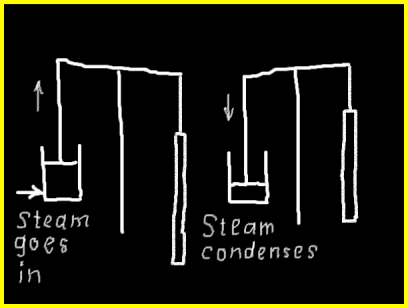
Newcomen beam engine
There were three pipes attached to the
lower part of the cylinder of Newcomen’s engine: one to
allow steam in from a
boiler, one to allow
cold water to be sprayed into the cylinder and one to allow
water to drain out of the cylinder. Each of these pipes had a
valve, much like an
ordinary tap, that could be opened or closed. Miss Tumble drew
the cylinder and labelled all the valves to help the children
to understand what the cylinder of
 Newcomen’s engine was like.
Newcomen’s engine was like.

Newcomen’s beam engine
Miss Tumble asked the children to imagine
that Thomas Newcomen was about to start up his steam engine.
Eve wanted to know if he was wearing overalls. Miss Tumble
wasn’t sure if they had overalls in those days. However,
she felt sure he would not have worn his good clothes. Early
steam engines were rather dirty because of the coal for the
fire, the smoke and the grease that was used for lubrication.
Rose wanted to know if he had had a beard. Miss Tumble thought
not, although she wasn’t sure of that either. So that
everyone would have the same picture in their minds,
she asked the children to suppose that Newcomen was standing beside his
steam engine dressed in blue overalls with
no beard. He had already fired up the boiler and the steam was
ready to flow.
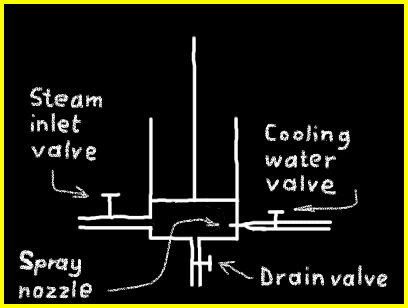
Valves and spray nozzle of Newcomen's engine
Newcomen opened the steam valve a little
and allowed steam to flow into the cylinder for a while. It
flowed out through the drainpipe and carried away the air that
had originally filled the cylinder. The steam also had the
effect of heating up the whole cylinder.
Freddie said that his mum sometimes heated
up the tea pot at home by holding it over the steam coming out
of the spout of the kettle. Then she threw the small amount of
water that formed by
condensation into
the sink before making the tea.
Miss Tumble said that Freddie
was very observant. She was very pleased that he had recognized
another example of condensation.
So, Thomas Newcomen had heated up the
cylinder of his steam engine just like the way that
Freddie’s mum heated up the teapot at home. There had
been a little condensation at first, which drained out through
the drain pipe. Once the cylinder was heated up there was no
need to waste any more steam by letting it flow out directly.
Newcomen closed the drain valve and then closed the steam inlet
valve so that the steam was trapped in the cylinder. Next came
the magical moment: Newcomen opened the cooling water valve and
sprayed cold water into the cylinder.
What happened? Well, Freddie and a few of
the other children could just about picture it already.
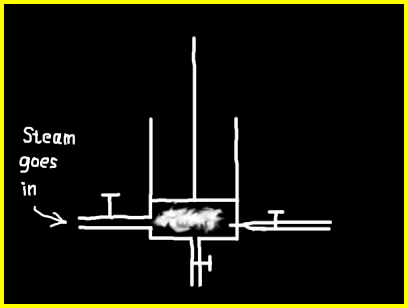
Steam enters Newcomen’s engine
The cold water caused the steam to
condense. There was now a
vacuum in the
cylinder and there was no longer any steam or air pushing the
piston upwards. Yet the
pressure of the
atmosphere was still pushing downwards on the piston so it
moved
down into the cylinder dragging its end of the
seesaw downwards.
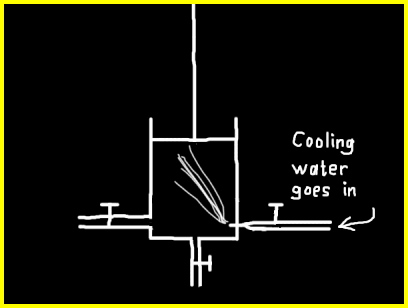 This had the effect of lifting the pump rod
at the other end. Newcomen’s engine was big and heavy and
this movement occurred slowly, but powerfully. When the piston was as
low as it could go
in the cylinder and the pump rod was as high as it could go
Newcomen opened the drain valve for just enough time to let the
water drain out of the cylinder again. Then he opened the steam
inlet valve.
This had the effect of lifting the pump rod
at the other end. Newcomen’s engine was big and heavy and
this movement occurred slowly, but powerfully. When the piston was as
low as it could go
in the cylinder and the pump rod was as high as it could go
Newcomen opened the drain valve for just enough time to let the
water drain out of the cylinder again. Then he opened the steam
inlet valve.
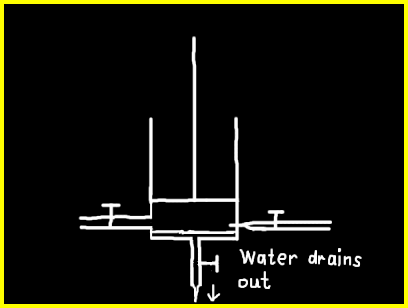 The steam entered the cylinder at
atmospheric pressure and the piston moved
up the cylinder again owing to the weight of the pump rod at
the other end of the beam.
The steam entered the cylinder at
atmospheric pressure and the piston moved
up the cylinder again owing to the weight of the pump rod at
the other end of the beam.

Cooling water is sprayed into cylinder of Newcomen's engine

Water drains out of Newcomen's engine
In order to make the beam of the steam
engine rock just once,
Newcomen had to open
and close the valve
that allowed the steam in; he had to open and close the valve
for the cooling water spray; and he had to open and close the
drain valve to allow the water out of the cylinder. It didn't
take Newcomen too long to find clever ways of using the
movement of the beam to operate the
steam valve, the water spray valve and the drain valve automatically.
That way the beam could continue to rock with a seesaw motion without
the need for a man to operate the valves by hand.
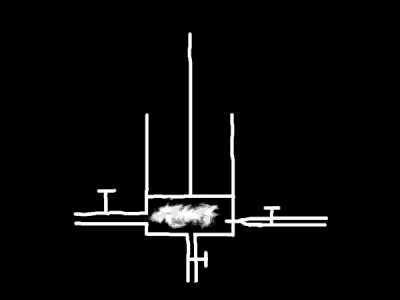
Animation of Newcomen’s engine cycle
When Miss Tumble asked the children for
their reactions to Newcomen’s steam engine, most of them
thought it had been quite a good idea for its time. Rose said
it would be great to attach Newcomen’s engine to the
seesaw in the local playground. That was a popular idea and so
was Roger’s suggestion of attaching Hero’s engine
to the roundabout. Miss Tumble said there would also have to be
a fire and a boiler to produce the steam to drive the two
engines. An adult would be needed to light the fire and then
mind it so that it would not go out. Eve was brave enough to
say that she did not like the idea of having steam and smoke
from a fire in the playground. On reflection, most of the kids
felt that they quite liked operating the roundabout and the
seesaw themselves, unaided by any engine.
